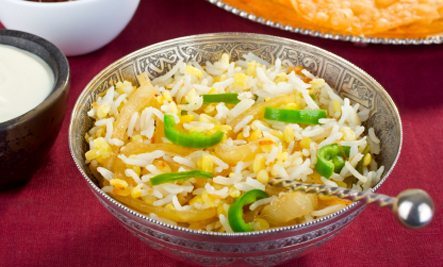
Ramadan Fasting Tips: Dietary Suggestions On How To Last The Fast
Jun 06, 2017
Ramadan isn’t just about refraining from eating; what you put in your system when you begin and break your fast is just as important for your well being. With our Ramadan fasting tips we list key foods to take when you are preparing to start and end your daily fast. So you can last!
On May 26, 2017, Ramadan, the ninth month of the Islamic calendar, began and millions of Muslims, including those who belong to the South Asian community, embarked on a month-long, daily spiritual journey where they fast from sunrise to sunset.
Daily fasting is not an easy endeavour and it is made more difficult when the body is fed oil-laden, salty or extremely sweet, yet oh-so-delicious foods such as paratha, pakora and chaat. Ironically, a month that is supposed to be about restraint and reflection turns into a glutton’s paradise at the start of the fast (sehri) and the breaking of the fast (iftar). The taste buds might be dancing the bhangra at the sight of delightful food but when you have headaches and suffer from excessive thirst during the workday, the joy of South Asian treats fades quickly.
The first step to alleviating the stress of the fast on the body is to alter the mindset. Sundown to sunrise is a time to prepare the body to go without food or water, it is not an excuse to eat salty and sweet foods. The focus should shift to foods that are easy to digest and maintain the mineral and vitamin balance that is necessary to function. Further, the foods should enhance elimination abilities because when there is less water in the system the waste is slower to exit.
Sehri — Breakfast with a Touch of Ayurveda
Coming from a South Asian background, Ayurvedic practises are a natural fit with the fasting routine.
- Lemon and warm water consumed at the start of sehri and several times throughout is a natural, optimal means to purify the liver, and the lemon’s light laxative effect will stave-off the risk of becoming constipated. When the body is deprived of water, waste just does not move as efficiently, so food choices are of optimal importance.

2. Coconut, a South Asian staple, is a fantastic source of potassium, which maintains the electrolyte balance, and other minerals such as zinc and selenium. The fruit is filling and should be chewed thoroughly, so as to ensure that your digestive system will not expend excess energy processing the meat. If by chance you have access to a fresh coconut, drink its water as its nutritional value is on par with the meat.

3. Watermelon is an excellent source of water and fruit sugar. It enhances your body’s water stores and it is a source of energy that will not lead you to crash two hours later. It is easily digested and is better than gulping down eight glasses of water in 30 minutes during sehri. Chew the watermelon and wash it down with the warm lemon water at a slow pace.

t
4. Almonds which have been soaked overnight with the skin removed is another Ayurvedic tip that helps the body to absorb the vitamin E, and adds zinc and calcium, without irritating the digestive system with the skin. A handful is filling, and since it is also an excellent source of nut protein it will stave off hunger for several hours.

5. Avocados are a good fat-rich fruit that keep your skin and hair shiny. They are rich in vitamin E, antioxidants and protein. Unlike watermelon, it is not sweet, but its creamy, nutty texture is easy to chew and digest when you are tired and just want to go back to bed.

All of the above fruit can be mixed into a smoothie with water as the base, or they can be eaten separately. Regardless of how you consume the fruit, they will fill you with minerals, vitamins and water which will hold you in good stead during the workday. A bonus is that there is literally no preparation required, you just need to chop them prior to consumption.
The Workday
The challenge is how to not develop a headache so severe that you become ineffective.
Energy exertion makes you lose water, so retain it by taking the elevator, rather than walking, and use your office “chat network” to send messages. Remember talking is an activity that requires saliva and the more you speak, the more you will become parched. Silence will help you to conserve water.
Since you expel moisture through sweat, urination and spit, in an environment that is likely rendered arid due to air conditioning, keep the air moist with a bowl of water or a humidifier placed next to your desk. The more moisture that is present in the air, the less your mouth will become dry and trigger the thirst response.
Another coping mechanism is to use essential oils to dissipate a headache. For example, if you are exhausted and need a boost between 3 p.m. and 4 p.m., when it is common to have a snack, sniff peppermint essential oil to revive the senses. If your head is pounding, the scent of lavender can soothe the pain.
Iftar — #Resist the Oil and Salt
Iftar is an interesting part of the day. The sense of relief that people feel when they tear into their dates at the precise moment Iftar opens is palpable. It is amazing that after a day of not eating, the digestive system which has been running on the Sehri meal is exposed to deep-fried vegetables and rich desserts. The digestive system literally goes from zero to sixty, and then there is the prayer break, followed by a full-scale desi feast filled with biryani, kebabs and naan.
I distinctly recall that people did complain of tummy aches but somehow managed to gulp down chai and galebis to finish off the night. These are the same people who could never figure out why they gained weight after Ramadan even though they fasted the whole month.
The key to Iftar is to gently revive the digestive system and replenish the vitamin, water and mineral stores that have been depleted over the course of the day.
Again Ayurveda tips complement the Iftar meal:
- Lentils are an excellent source of protein, in particular mung. This easy-to-cook and digest lentil mixes well with ginger and turmeric to create a digestive-friendly soup that adds protein, anti-inflammatory elements and aids in digesting fats better.

2. Leafy greens such as spinach and kale are important sources of calcium and vitamin A which are good for the bones, skin and cell repair. You can take handful of each leafy green, blend it with water, blueberries (a great anti-oxidant fruit that encourages waste elimination), and a tablespoon of psyllium husk (in Ayurvedic medicine this aids in staving-off constipation), to fit in your daily vegetables.

3. Bananas are delicious and add potassium to the system. They also soothe the lining of the stomach, are filling and make for an excellent dessert. This wonder fruit can also be added to the smoothie suggested in point 2 to add further natural sweetness.

4. Sweet potato is associated with the fall but they are available throughout the year which means that instead of filling your tummy with aloo ka paratha, you can bake a sweet potato and add vitamins A, B and C to your diet. Its sweetness will ensure that you will not miss out on the heavy, fried desserts and you will go to bed sated.

5. Kitchari is not my favourite dish but when the digestive system is under a new regime, the tummy aches that can follow biryani make this Ayurvedic, lentil-laden rice dish a wonderful, summer light alternative. Basmati rice is used in many Ayurvedic recipes, as it is easy to digest, and kitchari is another way to consume mung ki daal and spices.

The lightness and freshness of the dietary suggestions listed above pale in comparison to the feasts prepared by our parents but soar in terms of nutritional content and your ability to withstand the vigors of fasting. The exercise of fasting is a question of discipline but such discipline is enhanced when the digestive system runs smoothly and is treated with gentleness and respect — which is how Muslims are obligated to behave towards others, in particular, during the month of Ramadan.
Main Image Photo Credit: www.care2.com
Meena Khan | Features Editor - Beauty
Author
Meena (@meenalaregina) always loved the idea of exploring the non-conventional idea of beauty. Having grown up as a pimply chubby teenager, she wanted to see the change in the world that best reflected your uniqueness as well. Her well-received collection of blogs where she tries on various beauty p...













































































































